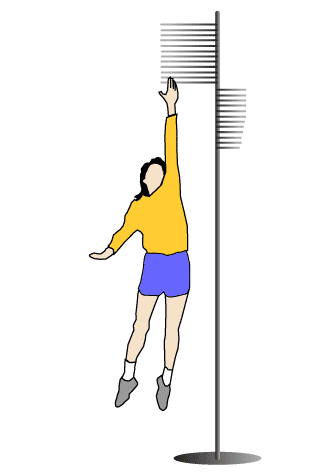The vertical jump test is a test of lower body power. The test was first described nearly 100 years ago (Sargent, 1921). The procedure below describes the method used for directly measuring the vertical jump height jumped. There are other methods such as using timing systems that measure the time of the jump and from that calculate the vertical jump height.
purpose: to measure the leg muscle power
equipment required: measuring tape or marked wall, chalk for marking wall (or Vertec® or jump mat).
pre-test: Explain the test procedures to the subject. Perform screening of health risks and obtain informed consent. Prepare forms and record basic information such as age, height, body weight, gender, test conditions. Perform an appropriate warm-up. See more details of pre-test procedures.
procedure (see also variations below): the athlete stands side on to a wall and reaches up with the hand closest to the wall. Keeping the feet flat on the ground, the point of the fingertips is marked or recorded. This is called the standing reach height. The athlete then stands away from the wall, and leaps vertically as high as possible using both arms and legs to assist in projecting the body upwards. The jumping technique can or cannot use a countermovement (see vertical jump technique). Attempt to touch the wall at the highest point of the jump. The difference in distance between the standing reach height and the jump height is the score. The best of three attempts is recorded.
variations: The vertical jump test can also be performed using a specialized apparatus called the Vertec®. The procedure when using the Vertec® is very similar to as described above. Jump height can also be measured using a jump mat which measures the displacement of the hips. To be accurate, you must ensure the feet land back on the mat with legs nearly fully extended. Vertical jump height can also be measured using a timing mat. The vertical jump test is usually performed with a counter movement, where there is bending of the knees immediately prior to the jump. The test can also be performed as a squat jump, starting from the position of knees being bent. Other test variations are to perform the test with no arm movement (one hand on hip, the other raised above the head) to isolate the leg muscles and reduce the effect of variations in coordination of the arm movements. The test can also be performed off one leg, with a step into the jump, or with a run-up off two feet or one foot, depending on the relevance to the sport involved. For more details see vertical jump technique.
scoring: The jump height is usually recorded as a distance score. See the vertical jump norm table to rate scores. For more information, see a selection of vertical jump test results. It is also possible to convert jump height into a power or work score.
advantages: this test is simple and quick to perform.
disadvantages: technique plays a part in maximizing your score, as the subject must time the jump so that the wall is marked at the peak of the jump.
comments: The jump height can be affected by how much you bend your knees before you jump, and the effective use of the arms. The test is also sometimes incorrectly spelled as the "Sergeant" or "Sargent" Test.
history: This method described above for measuring a person's vertical jump height is sometimes known as a Sargent Jump, named after Dudley Sargent, who was one of the pioneers in American physical education.
reference: Sargent, D.A. The Physical Test of a Man. American Physical Education Review, 26, 188-194. (1921)
Similar Tests
- Procedure for Vertical Jump Testing using a timing mat
- Procedure for Vertical Jump at home using a wall and chalk.
- Make your own Vertec® for cheap
- Vertical Jump off one step
- Vertical Jump from two feet
- One-Leg Vertical Jump — jumping from one leg, landing on both
- There is also the Max Touch basketball vertical jumping test using the Vertec®.
- Vertical Jump in the water (for water polo players)
- A similar test of leg power is the standing long jump test
- Drop Jump — a test of leg strength and power which requires the athlete to drop off a box and immediately jump as high as they can
Related Pages
- Vertical Jump Demonstration Videos
- A discussion about the various vertical jump equipment available.
- Poll: Which equipment do you use to measure vertical jump?
- Measuring standing reach height
- Vertical Jump test results
- Apparatus for sale in the vertical jump store
- About vertical jump techniques
- A history of the Sargent Test
- ChronoJump — for the measurement, management and statistics of jump time events.
- See the list of anaerobic tests for other fitness tests of leg power.
- The Vertical Jump test is part of the AFL draft and NBA draft testing procedures and used for the SPARQ rating system for many sports.
- World Records for the Vertical Jump
Old Comments
Commenting is closed on this page, though you can read some previous comments below which may answer some of your questions.
- Tupli (2014)
Does height affect the vertical jump test? - Add 15 Inches to Vertical Jump Tupli (2017)
Not really. It depends mostly on your leg strength. See Ivan Pedroso on youtube. There r a lot of other guys that aren't very tall who have jumped a long ways. Because distance is the product of speed and pop; run fast, push hard off the ground and try to launch yourself at a 45 degree angle. - Callum (2014)
this the best test to conduct if you are a basketball player - EuropaPointFC (2019)
competing to improve is better than measuring - EuropaPointFC (2019)
Excellent workouts for improve but not everythings sportsmen do needs to be measured - Mo (2020)
My experience with basketball has been a roller coaster of a journey, from practising with shooting, dribbling and endurance. However the main component of basketball is the ability to convert your energy to jump extremely high. One of the few exercises I thought I would have to do was the use of weights to do deadlifts and squats. My experience with basketball has not only been fun, but fulfilling as you are introduced with a range of workouts using no weights! Getting into shape has never been so easy! - Thomas Arvel (2018)
To be honest I've always had problems with vertical jumps in my entire life. When I played with my teammates I looked at them with envy because most of them easily made a dunk while I was not even close to reach the basket.
Not so long ago I decided that I will succeed in dunking no matter what. I kept reading books, searching online then I finally came across this program available online which finally gave me the results which I was looking for. Now when it comes to vertical jumps I have no more worry and I can focus on fixing other parts of my game :) - Radu Radoi (2017)
Before starting Vert Shock I was just grazing the rim.. After week 7 I threw down my first dunk! - LaMont Frazier (2017)
Stretching is key to becoming a great leaper. - Billy reid (2016)
i need to know how to... - Eijay Nini (2017)
Good Day Sir/ Ma'am,We the fifth year Physical Therapy students of Cebu Doctors University from the Philippines, are currently having our research study entitled "Acute Effects of Dynamic Core Exercise on Vertical Jump among Cebu Doctors' Volleyball Players" would like to ask permission to use your tool "Sargent Jump Test" that is found on your page. We just want to apply the test in our study and not use your material for other publications.Your respond would be a big help to our study Sir/ Ma'am. Hoping for your kind consideration. - Rob Admin Eijay Nini (2017)
Hi Eijay. This is a standard test procedure and you are free to use it as you wish. In a research study it would be best for you to reference a published research paper about the vertical jump procedure



